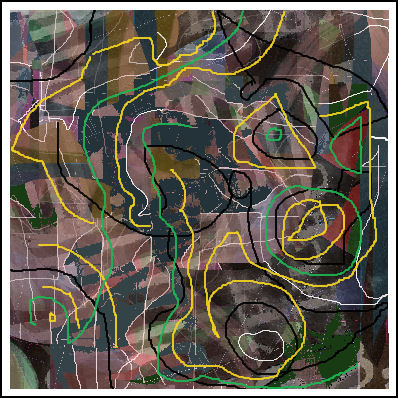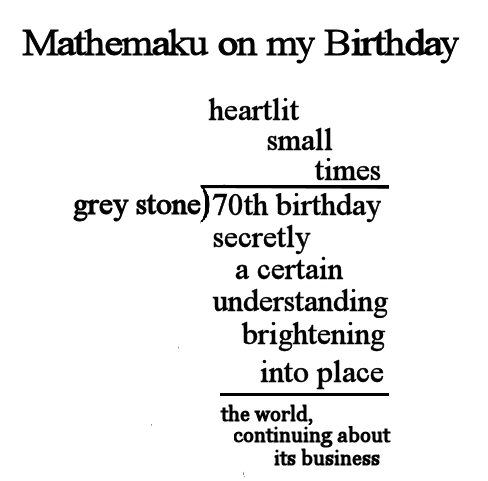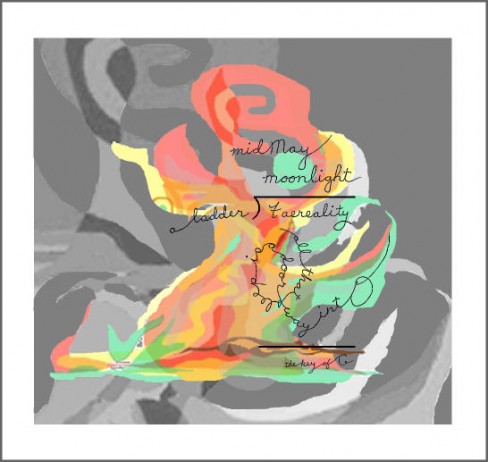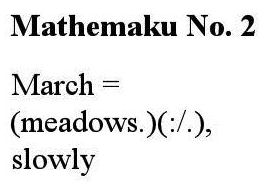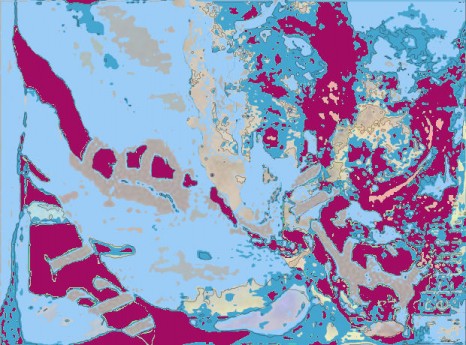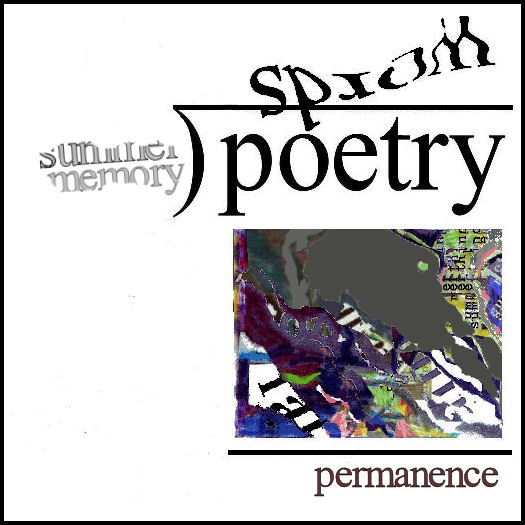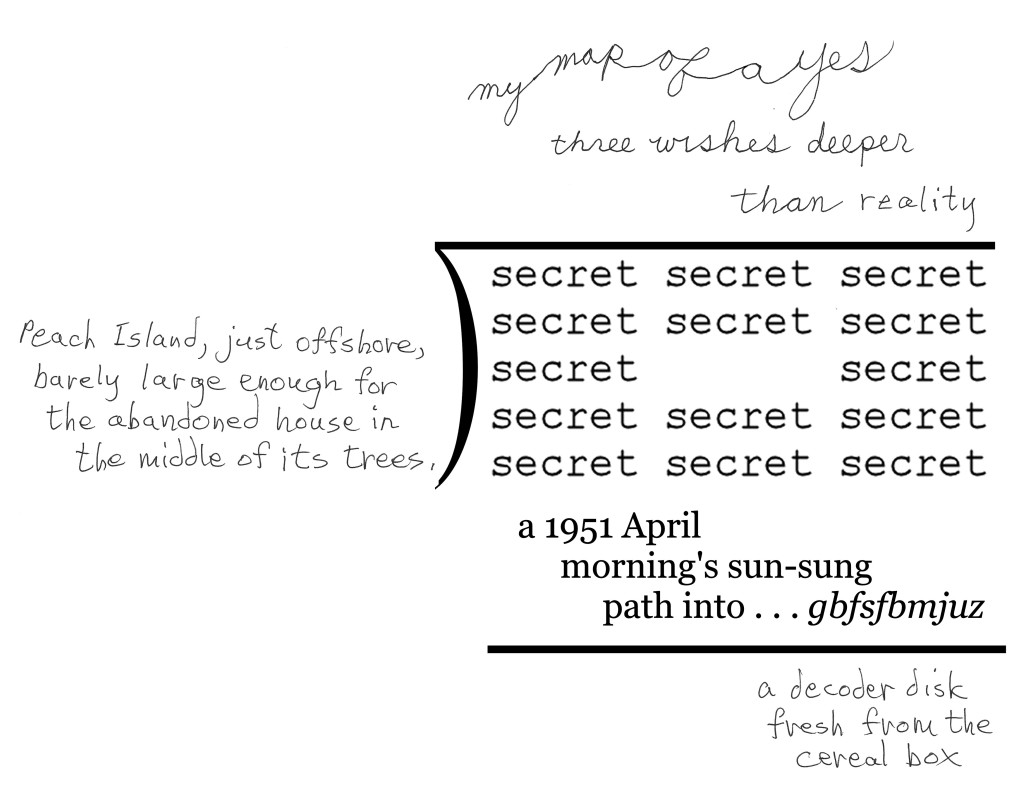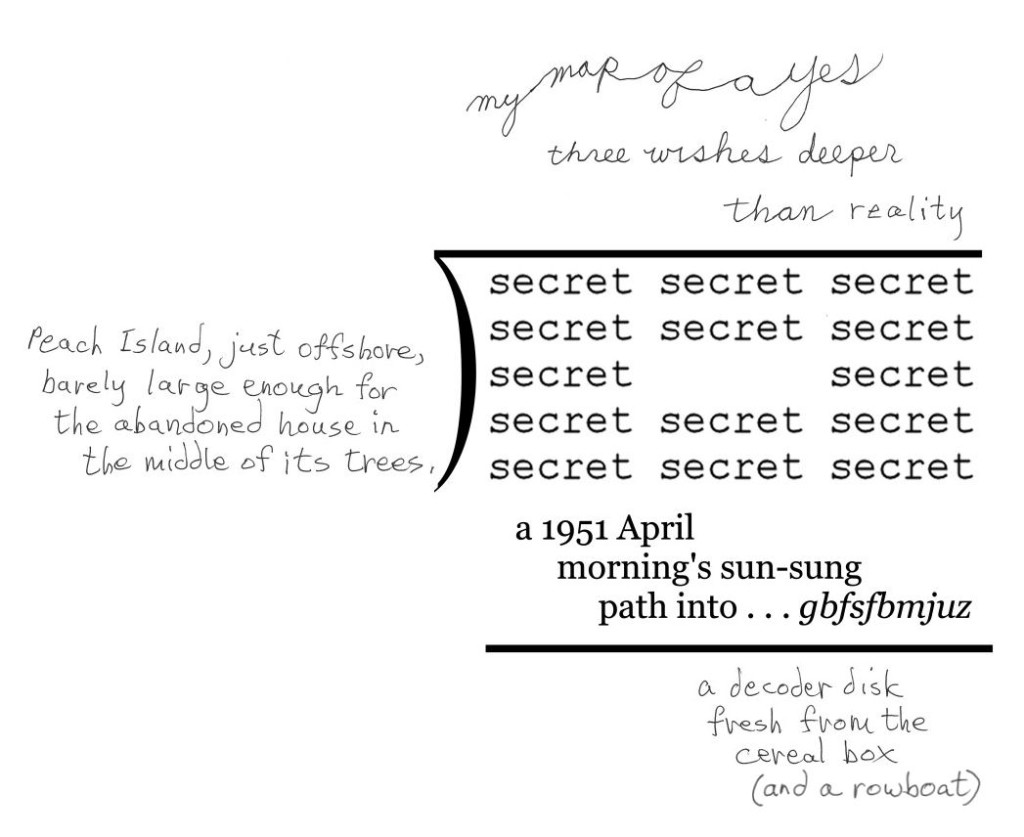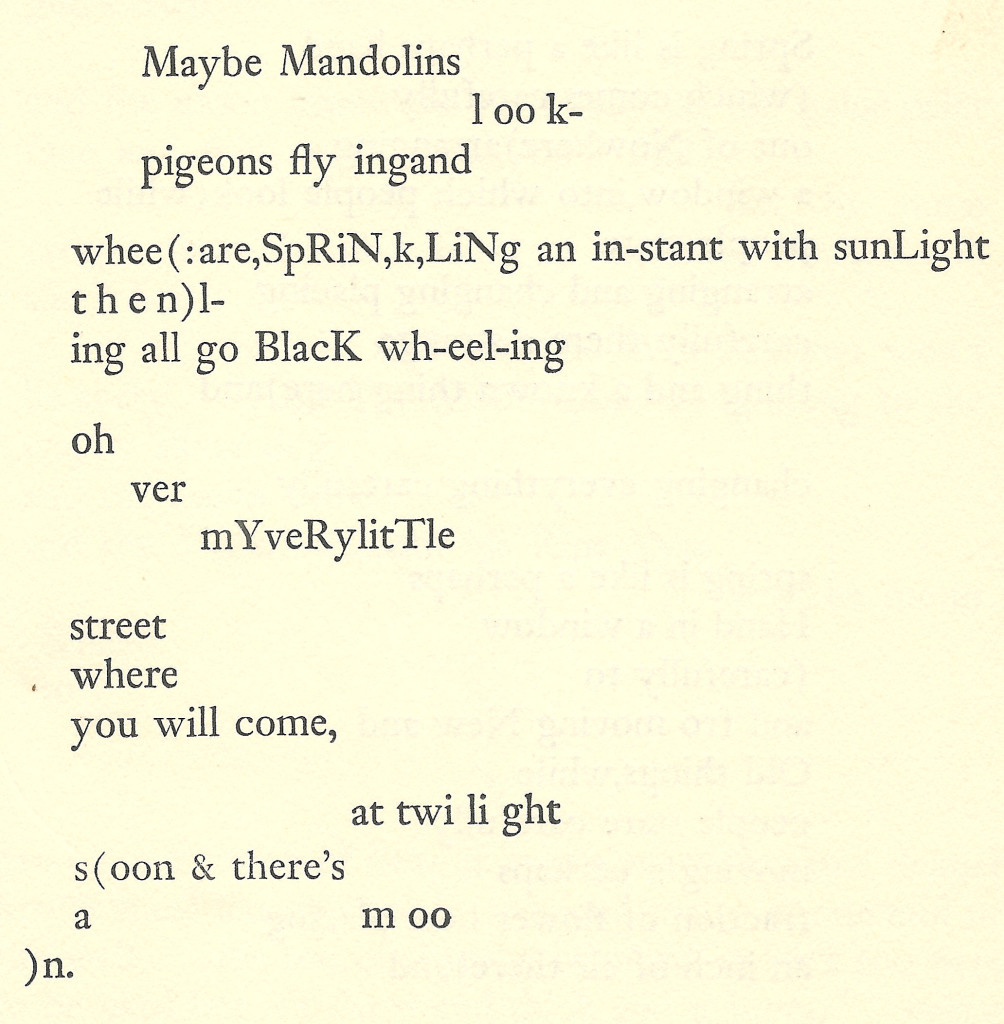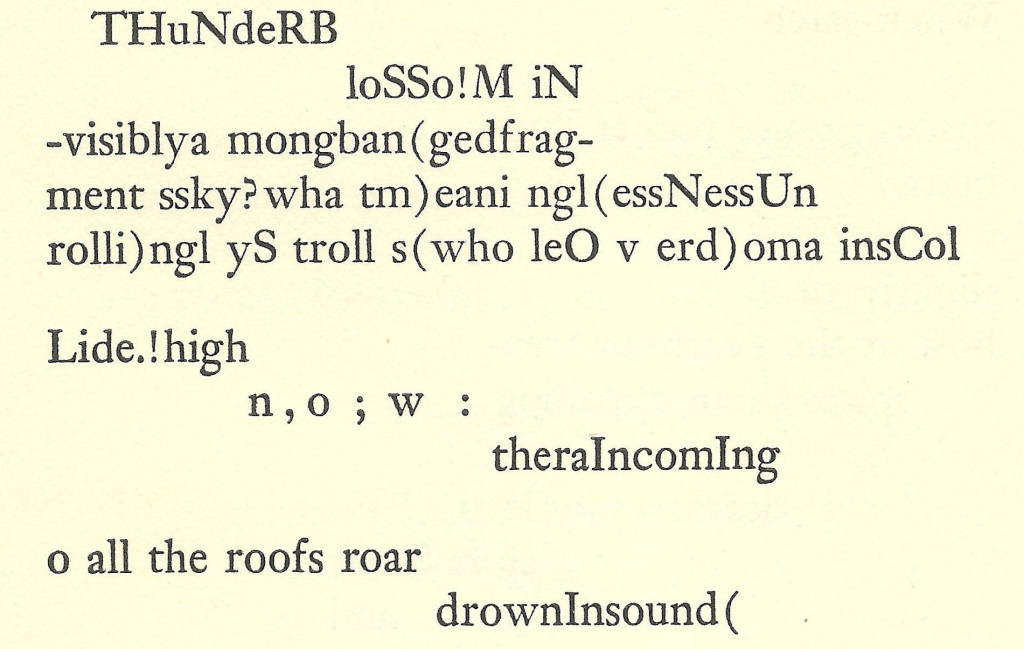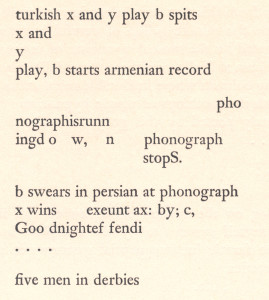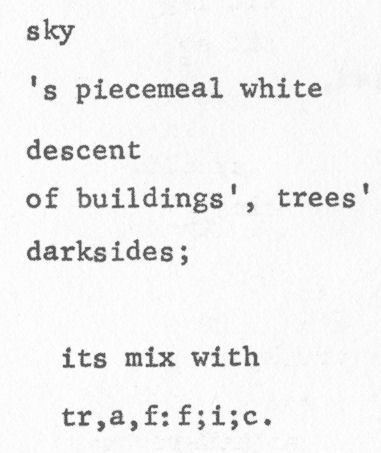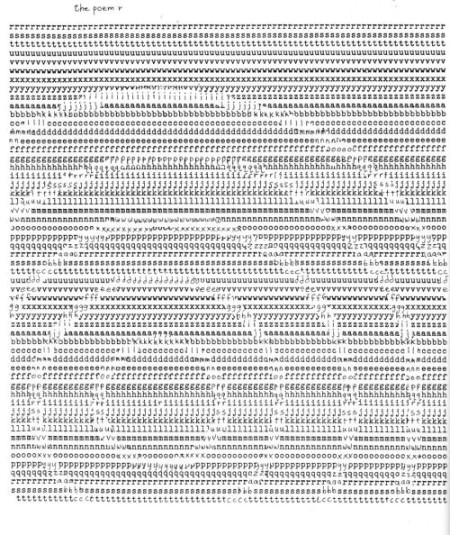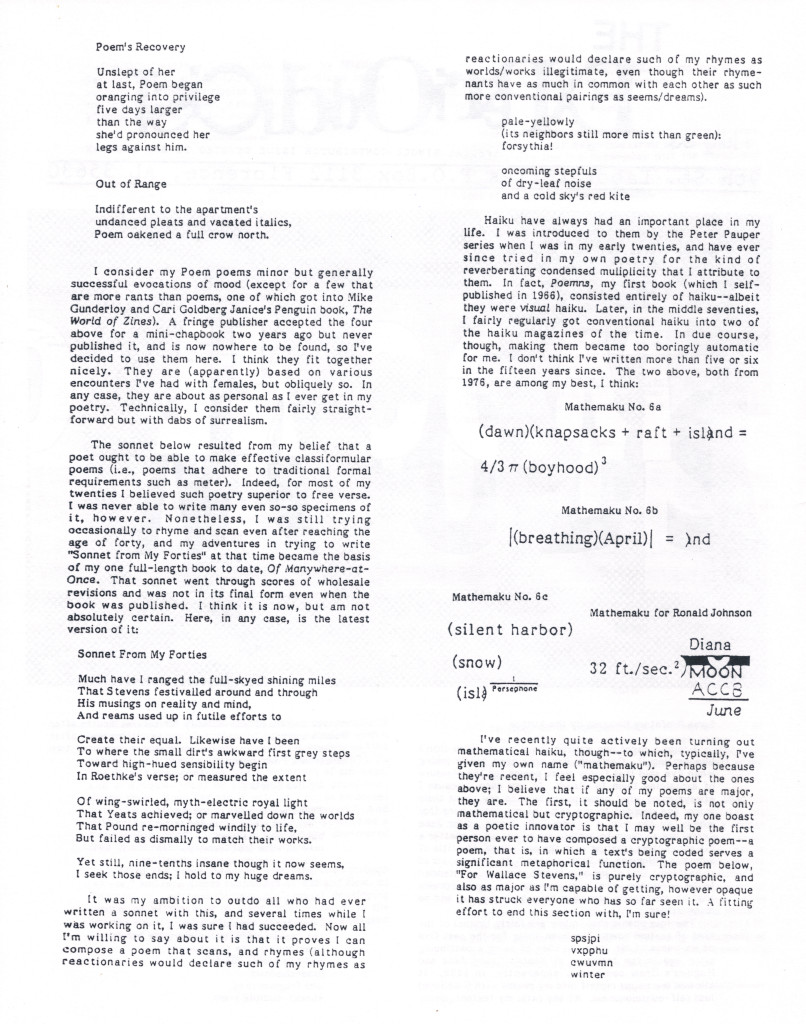Archive for the ‘Bob Grumman’ Category
Entry 645 — Xerolage30
Saturday, February 4th, 2012
Xerolage30 is the issue of mIEKAL aND and Liz Was’s Xexoxial Editions’ series of one-author collections of visiotextual art that was devoted to my work. I was looking through it for accessible purely visual poems to use in my next local exhibit. I wasn’t too happy with how little pleasure the items in it gave me, although the objective part of my brain told me they were mostly pretty good. I ended choosing eleven of the 20 or so in the collection. I’m not sure how many I’ll use–no more than seven or eight, probably, because I want half my pieces to be fairly recent mathemaku. I may not use the following, which is the (not too accessible) mathemaku I made for the cover of Xerolage30:
I think of this as sort of parallel to Yeats’s “The Circus Animals’ Desertion,” for it’s a summary of what’s in Xerolage30, many of my best poems at the time of publication. The divisor is where the mid-heaven is in my astrological chart, so represents my poetic career peak. The poems in Xerolage30 times that peak equal the collage of fragments from many of the pieces in my collection, with a remainder of “mystery,” and other things from my “Odysseus Suite.”
.
Entry 644 — My Annual Birthday Present from Geof
Friday, February 3rd, 2012
Every year Geof Huth posts some kind of “homage” to me on my birthday–which, as everyone should know is 2 February, Groundhog Day, the same as James Joyce’s and Ayn Rand’s. The same as Tom Smothers’s, too! And just a tick from Gertrude Stein’s, 3 February, I’m relieved to say. The one he just posted here may be his best yet. It consists of a series of dictionary definitions of words having to do with my personal life (such as “connecticut,” the state I was born in) and my obsession with defining poetics (and the universe). Very funny, in good part because of his cruelly accurate understanding of me.
.
Entry 641 — Another Textual Design
Tuesday, January 31st, 2012
This is the third in the series of reworkings of an old textual design I posted the first two of in Entry 637. Useful for entries I have nothing else for, which are becoming standard for me, now.
I like this but am not sure why. It holds my interest. I seriously wonder whether it indicates I have a talent for this sort of thing. It seems to me anyone could use Paint Shop to make other designs equal to or better than it. The “asemic poems” I’ve seen posted usually seem as interesting to me as it. Oh, well, I enjoy making these, so as my mind fades away, I guess I’ll continue to.
.
Entry 633 — Kinds of Poetry, Again
Monday, January 23rd, 2012
At Spidertangle there’s been a discussion of how visual poetry sells. Poorly, needless to say. Along the way, John M. Bennett said, “Yes, the discussions about vispo can sometimes be interesting – a game, as you say – – – tho i think what they tend to miss is that the poetry we’re trying to create is much more than simply visuality. for me at least, the poem i try to make functions visually, sonorously, textually, conceptually, formally, metaphysically, metaphorically, ambiguously, performatively, etc etc etc and all equally importantly and at the same time. so from that perspective a discussion about vispo or soundpo or whatever misses most of the picture. or, it’s a game, something sui generis, of interest as a kind of thinking in its own category.”
I added: “Further thoughts: that there are two kinds of poetry: people poetry and a different kind I haven’t thought of a good name for. A people poem either states an opinion about human life which those who like the poem like it because they agree with the opinion; or it expresses a human feeling that those who like it empathize with. The other kind may also express an opinion and/or feeling (actually, it can’t avoid doing this to some degree), but has what I think of as larger interests of the kind John listed. The most important of these for me are aesthetic—what the elements of a given poem are doing rather than what they are saying. I think there is only a very small audience for such poetry, similar to the audience for avant garde music or mathematics.”
Entry 632 — A Step Beyond Designage
Sunday, January 22nd, 2012
I fooled around with a portion detached from the design I posted here yesterday for a little while, overlaying it with some oil paint brush strokes and a sailing vessel. Viola: the thing now had enough connection to reality to take on meaning–in a manner I thought very similar to what Klee’s best paintings do. It remains a textual design, though.
.
Entry 631 — Continuing Out-of-Itness
Saturday, January 21st, 2012
Many of the times I’ve been as out of it as I am now, I gone to Paint Shop and thrown together some bit of non-representational visimagery. So I tried that this after noon. After I had my design, I layered an old textual visimage over it to get:
I find it interesting but tend to think anyone with access to Paint Shop or software like it could have made it.
.
Entry 623 — My Decline
Friday, January 13th, 2012
Well, according to astrology, I’ve begun to decline vocationally after reaching my peak a week or two ago. It wasn’t much of a peak. I got my art on display, but doubt that more than a handful of people have looked at it, and probably no more than one or two has really looked at it. I haven’t been very productive, either. I’m going to return to my Shakespeare book today (after a little head-start last night). My intention is to either finish it, or–if I have significant trouble with it–switch to another project of mine, a non-fiction book that may be of general-interest but I’ll say no more about–to keep its theme, which is original, I think, and will be its main selling point, a secret. I will say that it’s about life in general, not about Shakespeare, psychology or poetics.
To make this entry more than a diary entry, here’s a poem of mine from a year or so ago. I posted it then, but just now made a slight change to it, making a whole new poem. I changed “full” to “certain.” I decided the implication that I’d come to understand everything was dumb. Now what kind of understanding I’d achieved is unclear, but should come across as Important. I don’t know whether this poem became visual later; I don’t think it did. I think it may work best as is, but who knows.
.
Entry 621 — Evolution of Style
Wednesday, January 11th, 2012
One of my works that I was particularly pleased with when I came across it while backing up blog entries was the following:
I have one problem with this: my only version of it is a low-resolution jpg, which I don’t know how to convert to high-resolution tif, except by simply redoing it. Any suggestions from anybody out there who knows more than I do about this kind of thing?
I didn’t re-post it only to ask for help, or because of how much I like it, but as an example of how my work as a poet has evolved. Actually, I want to show that it has evolved. That’s because Paul Crowley, the nut I most argue with on the Internet about who wrote the works of Shakespeare, seems not to believe that a poet’s style, or way of making art, evolved once he’s past his apprenticeship. Of course, he will claim I’m not a poet, and that the evidence I’m about to produce to show my evolution indicates only trivial changes, not anything like genuine evolution. I enjoy talking about my work, and analyzing any poem, so will go ahead with my demonstration, anyway.
First of all, I should state my claim: it is that over the past couple of years, my style as a poet has evolved appreciably, and that this poem illustrates it.
(1) I only began using cursive ten or fewer years ago, and never for more than a word or two. This poem and two others have all or most of their texts in cursive. Because the difference in expressiveness between print and cursive is visiopoetically meaningful to those who appreciate visual poetry, this wholesale use of cursive script counts as a significant evolution of style.
(2) My use of cursive is more elegant here than it is in mt other two recent poems making extensive use of cursive. Note, for instance, the large O, and the increased gracefulness of all the letters compared with the letters in my other two cursive poems.
(3) Twenty years ago, I didn’t bother giving my poems backgrounds. Since then I have, and have slowly been improving (but have plenty of room for further improvement). Note the harmony of the background’s shape and colors with the text, especially the O.
(4) The background has another important value–the connotations it picks up as a result of its being a variation (mostly through color changes) of the background in another poem of mine. Connecting poems of mine with others’ poems and others of my own poems is another way I’ve evolved as an artist, not doing it until perhaps twenty years ago, then only very slowly doing it to a greater and greater extent. This poem may be the first to re-use an entire background from another poem. This is not trivial, for it allows this poem to suggest “dictionary-as-temple,” the main part of the foreburden of the poem its background is from. It also should make this poem easier to enjoy, the same way the repetition in a new musical work of an old theme is usually pleasant to hear. I believe the happiness of the colors of this version of the background gains from the reminder of the different, lower-key mood evoked by the other version.
(5) The use of color in tension with greyscale is another trick new to me twenty years ago that I exploit more and more in my present works, as here (though I’ve done more with it elsewhere).
(6) I think my language has evolved over the years, too–from fairly literal to metaphorical and/or surreal. The “logic” of this piece and most of my recent pieces is not so easy to guess, which may be an unfortunate evolution, but an evolution nonetheless.
(7) You can’t tell from this image, which has been reduced in size to fit the normal computer screen, but the hard copy is larger than anything I did ten or more years ago, which is another result of evolution.
Here’s my first or second mathemaku, done thirty or more years ago, to make the profound evolution of my style more inescapable. Yet I maintain this piece is at the level of later pieces; it is simply more condensed. For one thing, it is only linguistic and mathematical. Nothing visioaesthetic happens in it. The eye is used only to recognize the symbols it contains, not to enjoy colors or shapes the way my faereality poem compels it to–i.e., not a visual poem (except inthe mindlessnesses of those for whom just about everything is a visual poem). It is short, and printed. Its words are simple to an extreme.
.
Entry 590 — Playing at Being an Abstract-Expressionist
Sunday, December 11th, 2011
This is a third version of the subdividend product in my division of “the the” poem:
I quite like it. I experimented with quite a few different colors, none of them seeming to work until I added the maroon, which made a huge difference for some reason. Now I have to figure out how to use it in a poem.
* * *
Saturday, 10 December 2011, Noon. I have to get my Christmas chores–basically a Christmas letter and cards–out of the way. So I’ll be concentrating on that for a few days. I just posted my blog entry for today, and I arranged it so my second printer can print some copies of my “Christmas Mathemaku, No. 1,” which takes care of my pledge to work daily on something connected to the exhibition–but I hope to do more, like print out some copies of it. I want to try to sell a few signed copies at the A&H office. I lost the morning to tennis, and the after-tennis coffee session, this time at a Dunkin’ Donuts place. I sometimes think I should give up tennis–becauwse (1) I’m lousy at it and (2) it takes time from my cultural activities. But I’m pretty sure I need it–as a break from cultural activities, and for simply being with others. The exercise is probably good for me, too. I have to admit that it can be fun when I’m not too horrible (as I was this morning).
6 P.M. This afternoon I went out on my bike again. I got two more picture frames, some ink for my new printer ($100!) and had some things printed out–parts of my very large “Mathemaku for Scott Helmes.” Since then, I’ve put my “Christmas Mathemaku, No. 1″ into a frame. Haven’t done much else.
.
Entry 589 — A Spin-Off
Saturday, December 10th, 2011
The poem below is something I spun off the mathemaku I posted yesterday. I made it mainly because I wanted to use a complete long divion poem as a term in a larger long division–something I’ve done once before but have never been satisfied with.
* * *
Friday, 9 December 2011, 8 A.M. Now that I’m starting to get things done, my luck has soured. A while ago I was getting ready to take the three framed works I now have for counter-display to the Arts&Humanities Council office. I could only find two. I was carrying the missing one around in my bicycle basket a few days ago. Looks like someone grabbed it. Unless I found a some incredibly stupid place to hide it from myself here. Luckily the frame was a cheap one, and the poem, which I’m sure the ones who stole it had not interest in (if they stole it for the poem, I’d be very pleased) is about the easiest of the ones I have to zap out another copy of. It’s the “Hi” one. But I’m out ten dollars or so, and have to ride out to get another frame, a wearying chore that upsets my plans for the day.
It is now a little after nine. Just as I was about to leave to get a new frame and take care of a few other errands, I found the “stolen” work. It was in a packing envelope (as I remembered it had been) and right in the chair I would naturally have put it in after getting back from the bike ride I’d had it with me on. My jacket was draped over it, but not entirely over it. I should have looked where it was as soon as I thought it lost. I’m not going senile–I’ve been doing things like that all my life. I must say, I feel a lot better. And something good came from it: needing another copy of the poem, I fooled around with it at Paint Shop and improved it. (Hey, that counts as my work for day on exhibition-related matters!)
It’s now eleven. I did some more work concerned with the exhibition: I went to the A&H office and talked to Judy, the lady in charge. I got a better idea of things from her–such as the date of the opening (3 January 2012).
5 P.M. and I’ve corrected my “A Christmas Mathemaku,” which I’ve always considered a potential crowd pleaser, and done a write-up on it. I plan to leave a framed copy of it at the Grumman Exhibition Center on Monday.
.

